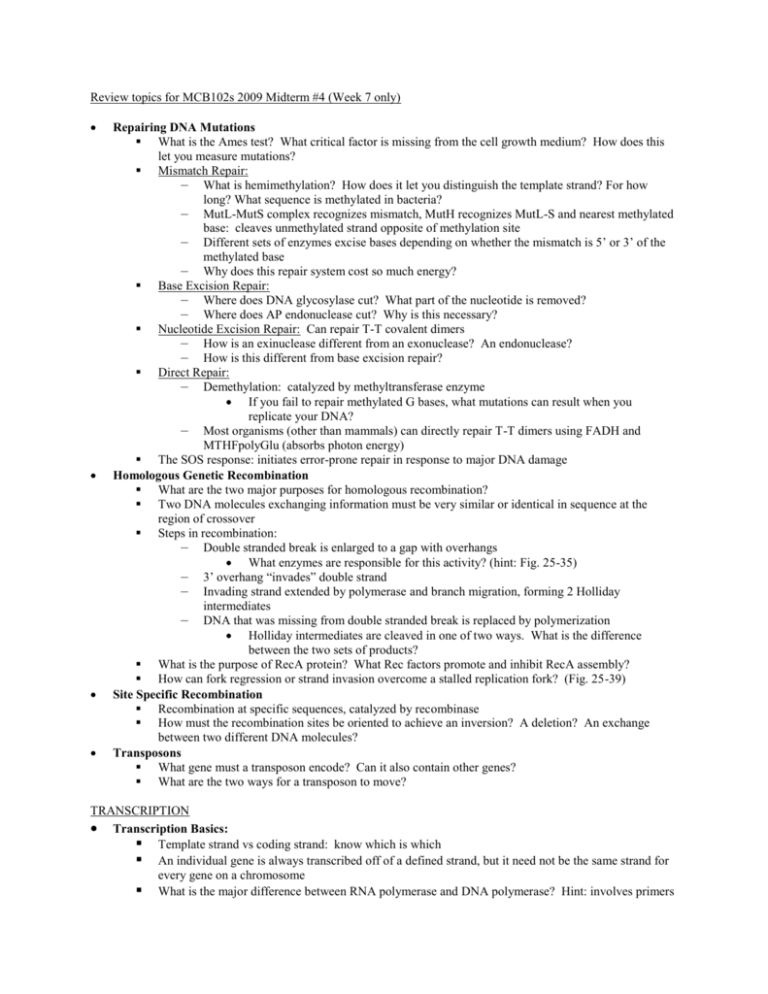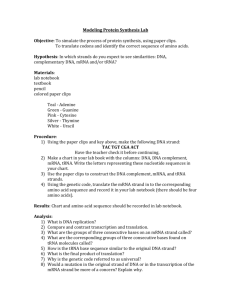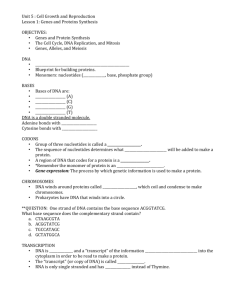Review Topics for Final Part 1
advertisement

Review topics for MCB102s 2009 Midterm #4 (Week 7 only) Repairing DNA Mutations What is the Ames test? What critical factor is missing from the cell growth medium? How does this let you measure mutations? Mismatch Repair: — What is hemimethylation? How does it let you distinguish the template strand? For how long? What sequence is methylated in bacteria? — MutL-MutS complex recognizes mismatch, MutH recognizes MutL-S and nearest methylated base: cleaves unmethylated strand opposite of methylation site — Different sets of enzymes excise bases depending on whether the mismatch is 5’ or 3’ of the methylated base — Why does this repair system cost so much energy? Base Excision Repair: — Where does DNA glycosylase cut? What part of the nucleotide is removed? — Where does AP endonuclease cut? Why is this necessary? Nucleotide Excision Repair: Can repair T-T covalent dimers — How is an exinuclease different from an exonuclease? An endonuclease? — How is this different from base excision repair? Direct Repair: — Demethylation: catalyzed by methyltransferase enzyme If you fail to repair methylated G bases, what mutations can result when you replicate your DNA? — Most organisms (other than mammals) can directly repair T-T dimers using FADH and MTHFpolyGlu (absorbs photon energy) The SOS response: initiates error-prone repair in response to major DNA damage Homologous Genetic Recombination What are the two major purposes for homologous recombination? Two DNA molecules exchanging information must be very similar or identical in sequence at the region of crossover Steps in recombination: — Double stranded break is enlarged to a gap with overhangs What enzymes are responsible for this activity? (hint: Fig. 25-35) — 3’ overhang “invades” double strand — Invading strand extended by polymerase and branch migration, forming 2 Holliday intermediates — DNA that was missing from double stranded break is replaced by polymerization Holliday intermediates are cleaved in one of two ways. What is the difference between the two sets of products? What is the purpose of RecA protein? What Rec factors promote and inhibit RecA assembly? How can fork regression or strand invasion overcome a stalled replication fork? (Fig. 25-39) Site Specific Recombination Recombination at specific sequences, catalyzed by recombinase How must the recombination sites be oriented to achieve an inversion? A deletion? An exchange between two different DNA molecules? Transposons What gene must a transposon encode? Can it also contain other genes? What are the two ways for a transposon to move? TRANSCRIPTION Transcription Basics: Template strand vs coding strand: know which is which An individual gene is always transcribed off of a defined strand, but it need not be the same strand for every gene on a chromosome What is the major difference between RNA polymerase and DNA polymerase? Hint: involves primers PROKARYOTIC Transcription: What makes up the RNA polymerase holoenzyme? What is the purpose of the different sigma subunits? When do they dissociate from the rest of the complex? What elements are common in E. coli promoters? Understand the +/- location system. What is the difference between rho-dependent and rho-independent termination? What nucleotides signal each kind? EUKARYOTIC Transcription: How many polymerases do we have? What type of RNA does each transcribe? What elements are found in Pol II promoters? What is the key domain of Pol II mentioned in lecture? What processes is it involved in? General transcription factors are required for translation of all transcripts. Ones to note are TFIIH and TBP. What do they do? Be aware of the different inhibitors mentioned in class. RNA Processing (Eukaryotic) Addition of 5’ cap: where/when does this happen? What does it do? How is the cap linked to the mRNA? Intron splicing: — Which types are self-splicing? What does self-splicing mean? — What is the difference between Group I and II introns? — Group III: What kinds of molecules make up the spliceosome? What is an snRNP? What purpose do guide RNAs serve? What characteristic sequence is left behind in an mRNA after intron removal by the spliceosome? — What is alternative splicing? Polyadenylation: — What has to happen to the mRNA before the poly-A tail is added? — What enzyme adds on the A’s? — What purpose does the polyA tail serve in eukaryotes? — Why might a protein have multiple poly(A) sites? How are rRNA and tRNA primary transcripts processed to yield mature r- and tRNA? Synthesizing DNA from RNA What component of telomerase allows it to promote addition of DNA bases to the ends of chromosomes? Why is this necessary? What happens to the 3’ overhang that is left over? What critical enzyme is necessary for viruses to convert their RNA to DNA? How does the compact viral genome yield so many different proteins? TRANSLATION The Genetic Code Know the terms codon, anticodon, reading frame, and open reading frame How would an insertion or deletion mutation affect the reading of an mRNA? What are overlapping reading frames? Where are they typically found? RNA editing: mRNA is altered (insertion, deletion, base change) to produce the desired sequence tRNAs What is the wobble theory of anticodons? Which base is the wobble base? What are the advantages of the wobble base system? Typically, each aminoacyl tRNA synthetase is specific for one amino acid and its corresponding tRNAs (may be more than one) Two different classes of synthetases attach the amino acids in slightly different ways Does it cost energy to “charge” a tRNA with an amino acid? What proofreading mechanism ensures that the right amino acid is added? Different sequences in varying tRNAs allow recognition by the right synthetase The Ribosome Two subunits: Large (50S or 60S) and small (30S or 40S), each made up of RNA and protein What are the 3 sites for tRNA in the prokaryotic ribosome? What happens in each site? (Note: eukaryotic ribosomes have no E site) PROKARYOTIC Initiation When does translation start in eukaryotes? (i.e. how long after transcription?) 30S + initiation factors + mRNA bind together first — What is the Shine-Dalgarno sequence? Why is it important for initiation? fMet-tRNA and 50S subunits then join — Modified Met (fMet) and its special tRNA is the only pair that can bind directly to the P site EUKARYOTIC Initiation PABP binds poly(A) tail, eIF4F complex (including 4G, 4E, and 4A) binds to PABP and to the 5’cap, forming an mRNA loop 4F complex recruits eIF3 and 40S ribosome subunit—ribosome scans through 5’UTR (untranslated region) until it finds a start codon, then 60S subunit joins Elongation and Termination (pro- and eukaryotic very similar) Incoming tRNA binds EF-Tu-GTP, whole complex binds to the A site — What mechanism allows for proofreading at this point? How is the new amino acid added to the peptide chain? (What attacks what? What moves where?) What factors are necessary for translocation? Energy required? What do the release factors recognize? What are polysomes? What are the different translational inhibitors mentioned in class? Which ones are pro- or eukaryotic specific? Posttranslational Modifications: Addition of isoprenyl groups (i.e. farnesyl): what property does this add to a protein? Signal peptide: — What are the characteristics of an ER-targeting signal sequence? — What recognizes a signal sequence? — Where is the ribosome-mRNA complex delivered after detection of a signal sequence? — What happens to the signal after translation? Glycosylation: what purposes does glycosylation serve? Ubiquitination: What is the purpose of the ubiquitin tagging system? What recognizes ubiquitinated proteins?









